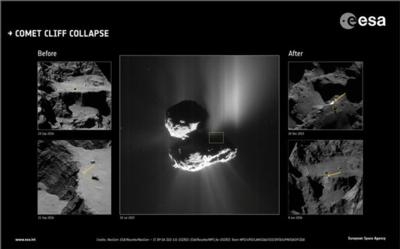Rosetta Spacecraft Provides Images Of The Event
Rosetta scientists have made the first compelling link between an outburst of dust and gas and the collapse of a prominent cliff, which also exposed the pristine, icy interior of the comet.

Sudden and short-lived outbursts were observed frequently during Rosetta’s two-year mission at Comet 67P/Churyumov–Gerasimenko. Although their exact trigger has been much debated, the outbursts seem to point back to the collapse of weak, eroded surfaces, with the sudden exposure and heating of volatile material likely playing a role.
In a study published in Nature Astronomy, scientists make the first definitive link between an outburst and a crumbling cliff face, which is helping us to understand the driving forces behind such events. The first close images of the comet taken in September 2014 revealed a 70 m-long, 1 m-wide fracture on the prominent cliff-edge subsequently named Aswan, in the Seth region of the comet, on its large lobe.
Over the course of the following year as the comet drew ever closer to the Sun along its orbit, the rate at which its buried ices turned to vapour and dragged dust out into space increased along the way. Sporadic and brief, high-speed releases of dust and gas punctuated this background activity with outbursts.
One such outburst was captured by Rosetta’s navigation camera on 10 July 2015, which could be traced back to a portion of the comet’s surface that encompassed the Seth region. The next time the Aswan cliff was observed, five days later, a bright and sharp edge was spotted where the previously identified fracture had been, along with many new metre-sized boulders at the foot of the 134 m-high cliff. “The last time we saw the fracture intact was on 4 July, and in the absence of any other outburst events recorded in the following ten-day period, this is the most compelling evidence that we have that the observed outburst was directly linked to the collapse of the cliff,” says Maurizio Pajola, the study leader.
The event also provided a unique opportunity to study how the pristine water-ice otherwise buried tens of metres inside the comet evolved as the exposed material turned to vapour over the following months. Indeed, after the event, the exposed cliff face was calculated to be at least six times brighter than the overall average surface of the comet nucleus. By 26 December 2015 the brightness had faded by half, suggesting much of the water-ice had already vapourised by that time. And by 6 August 2016, most of the new cliff face had faded back to the average, with only one large, brighter block remaining.
In addition, the team had a clear ‘before and after’ look at how the crumbling material settled at the foot of the cliff. By counting the number of new boulders seen after its collapse, the team estimated that 99% of the fallen debris was distributed at the bottom of the cliff, while 1% was lost to space. This corresponds to around 10,000 metric tons of removed cliff material, with at least 100 metric tons that did not make it to the ground, consistent with estimates made for the volume of dust in the observed plume.
Furthermore, the size range of the new debris, between 3 m and 10 m, is consistent with the distributions observed at the foot of several other cliffs identified on the comet. “We see a similar trend at the foot of other cliffs that we have not been so fortunate to have before and after images, so this is an important validation of cliff collapse as a producer of these debris fields,” says Maurizio.
But what actually led to the cliff suddenly collapsing at this particular moment?
An earlier study suggested that both rapid daily changes in heating or longer-term seasonal changes can create thermal stresses that lead to fracturing and subsequent exposure of volatile materials, triggering a rapid outburst that can cause the weakened cliff to collapse.
Even though the Aswan cliff region had been experiencing large temperature changes in the months before the collapse, interestingly, the collapse occurred at local night, ruling out a sudden extreme temperature change as the immediate trigger. Instead, both daily and seasonal temperature variations may have propagated fractures deeper into the subsurface than previously considered, predisposing it to the subsequent collapse. “If the fractures permeated volatile-rich layers, heat could have been transferred to these deeper layers, causing a loss of deeper ice,” explains Maurizio. “The gas released by the vapourising material could further widen the fractures, leading to a cumulative effect that eventually led to the cliff collapse.
“Thanks to this particular event at Aswan, we think that the cumulative effect led by strong thermal gradients could be one of the most important weakening factors of the cliff structure.”
“Rosetta’s images already suggested that cliff collapses are important in shaping cometary surfaces, but this particular event has provided the missing ‘before–after’ link between such a collapse, the debris seen at the foot of the cliff, and the associated dust plume, supporting a general mechanism where comet outbursts can indeed be generated by collapsing material,” said Matt Taylor, ESA’s Rosetta project scientist.
(Image provided with ESA news release)
 ANN's Daily Aero-Linx (06.29.25)
ANN's Daily Aero-Linx (06.29.25) ANN's Daily Aero-Term (06.29.25): Gross Navigation Error (GNE)
ANN's Daily Aero-Term (06.29.25): Gross Navigation Error (GNE) Classic Aero-TV: Anticipating Futurespace - Blue Origin Visits Airventure 2017
Classic Aero-TV: Anticipating Futurespace - Blue Origin Visits Airventure 2017 NTSB Final Report: Cirrus SR22
NTSB Final Report: Cirrus SR22 Airborne Affordable Flyers 06.26.25: PA18 Upgrades, Delta Force, Rhinebeck
Airborne Affordable Flyers 06.26.25: PA18 Upgrades, Delta Force, Rhinebeck



